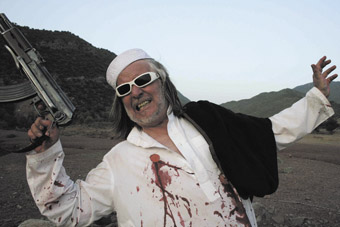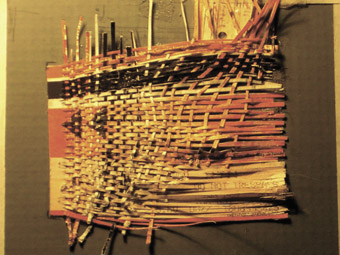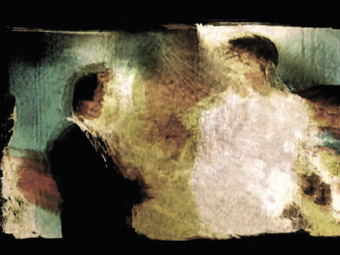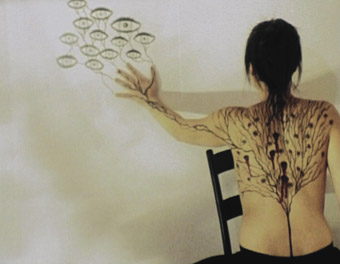the thin line between mainstream & underground
jane mills: sydney underground film festival

The Miscreants
THE MOST STARTLING MOMENTS AT THIS YEAR’S SYDNEY UNDERGROUND FILM FESTIVAL (SUFF) WERE NOT THE VOMIT, SLASHINGS, BLOOD, TURDS OR SLIME—THOUGH THERE WERE PLENTY OF THESE—BUT THE AUDIENCE’S DISBELIEF WHEN CONFRONTED BY THE MAINSTREAM, ESPECIALLY HOLLYWOOD. THIS REACHED A HIGH POINT AT THE AUSTRALIAN PREMIERE OF SLIPSTREAM, THE FEATURE-LENGTH MOVIE STARRING, WRITTEN AND DIRECTED BY ANTHONY HOPKINS, WHO ALSO WROTE THE MUSIC.
There were incredulous whispers: “Is this the Anthony Hopkins?”, “Anthony Silence of the Lambs Hopkins?”; “Sir Anthony Hopkins”? But indeed it was. Co-starring John Turturro and Christian Slater, Slipstream owes something to David Lynch but also to the globally dominant cinema that created Hopkins the Oscar-winning actor and has given us distantly similar forays into memory-lapse such as in the Bourne franchise movies. MTV also has some sort of relationship to the extraordinary and often extremely rapid editing in Slipstream that takes us in and out of the fantasy and reality in the mind of a Hollywood screenwriter (Hopkins) who may or may not be mad.
Slipstream was a real surprise for anyone believing the gap between mainstream and the underground to be huge and who define the underground in terms of its art and opposition to all that it is conservative, reactionary and commercial.

Ticketweavels
Another big surprise was the quantity and quality of Australian films. Caroline Huf’s Ticketweavels, for example, is a short, sad love affair between two Sydney train tickets that creates an animated existential crisis for the lovers. The deserved winner of the Material Effects award, Jessica Mutasco’s Paneye, is an impressive stop-frame exploration of corporeality as the conduit for converting inner perception into an external image. Peter Newman’s formal Paperhouse: the 5:19 is a disturbing video fusion of image and meaning. Geoff Wheatley’s achingly lovely Light/Strike (An Open Window) captures uncanny, wafting images from the past with a 1975 original Sony Portapak.

Paperhouse
And, as ever, Paul Winkler’s fertile imagination refreshed our inner-eyes with his glorious technicolour (not actually, but certainly glorious) Many Buddhas. Running film partially exposed in horizontal and vertical stripes and patterns through his camera as he has done for many years, Winkler’s images bore their way into our mind’s eye where they resonate, echo and repeat like a visual ear worm—while also managing to be different each time.
Was it the presence of senior filmmakers of the experience and calibre of Hopkins or Winkler which created a strong historical ether that pervaded the weekend? Whatever the cause, it became increasingly difficult to understand claims of the avant-garde to be at the forefront of filmmaking practice. In the turbulent storm of moving image art which is, or aims to be, ‘progressive’, the past tends to appear and reappear in underground cinema: it’s a two-way process and it is hard to know which way history’s angel is looking.

Paineye
The documentary, a genre devoted to the past is not widely associated with the underground although there are many instances—Buñuel’s 1932 Las Hurdes (Land without Bread) is a notable early example. Many of the docos at SUFF this year outshone the fictional, the abstract and the frequently rather conventionally formalist avant-garde and experimental and called into question the whole definition of underground.
George Gittoes’ The Miscreants is a superb documentary. Reflexive, self-deprecating, and fiercely political, this is the last in his trilogy about the impact of US aggression in the Middle East upon art and creativity. Humour and hyper-reality are so mixed up that it becomes impossible to know whether a gun or a camera is doing the shooting. One can’t always fathom who’s doing the shooting, nor distinguish between the good and the bad guys. Laughter quickly turns to chilling fear as realisation of the implications of Bush’s foreign policy sinks in.
SUFF co-director Stefan Popescu claims Gittoes is a ‘film artist’ who responds to state sanctioned terror through his art. But is he an underground film artist? His is a doco, after all, that might well be screened on mainstream television, perhaps even in the local multiplex.
Less difficult to categorise is the compelling Czech documentary, Lost Holiday (director Lucie Kralova). This makes innovative use of sound and form to shape a story about some missing holiday photographs into a mesmerising experimental transnational detective story and a reverie upon the role of the camera (still and moving) in the evermore intense and speedy passages of global cultural flows. This is more clearly the work of a film artist than many of those in the diverse collection screened over the weekend.
But does it make sense to claim the film artist for the underground? Where does this leave the national mainstream cinema? Over and over, Hollywood has not only proved the genius of its system by absorbing ideas, images, sounds and other cultural phenomena from alternative cinemas to create something new, but also by introducing invention and creative innovation to its so-called radical ‘other.’
One criticism I have of the SUFF is that too often the curators gave the benefit of the doubt to the film when more rigour would have been valuable. It’s not just that there were a few too many cute-but-naughty animated lumps of clay, silly penis jokes and women getting vigorously bonked from the rear (not always violently but usually so), but that these do not the underground make.
SUFF was successful, however, in showing just how heterogeneous the underground is and, in effect, pushing the definition of underground filmmaking to new (or back to old) boundaries.The festival offered films ranging from John Waters’ still outrageous 1981 classic Polyester to the undeniably enjoyable, if Tarantino/Rodriguez-inflected, Austrian On Evil Grounds (Peter Koller) which is more B-movie than underground; and from the wondrously abject New Zealand short Eel Girl (Jennifer Scheer) to Song Sung Blue, Greg Kohs’ documentary feature about the husband and wife tribute band, Thunder and Lightning. This very straight doco has been selected for some very conventional mainstream film festivals this year: does this make the Philadelphia or the Melbourne International Film Festival underground? Or does it mean that mainstream and avant-garde exist in productive tension?
I like blood, pus, piss, sex, cum and a good dollop of sparagmos and evisceration as much as the next underground addict. But it felt good to be reminded that the intellect can be challenged as well as the gut and the genitalia. After the weekend the SUFF morphed into a symposia and an art gallery event at the Sydney College of the Arts. Poorly attended, maybe, but hugely valuable.
We were treated to an exhibition curated by Jenny Brown of films and other artefacts by the New York’s celebrated underground Franklin Furnace Archive and some lunch-time lectures. Melbourne Underground Film Festival Director and filmmaker Richard Wolstencroft showed an extract from his new film, The Beautiful and the Damned, teaching us that the underground can include a film based on a book that appears on many an undergraduate literature reading list. Sydney experimental media artist, lecturer and author John Conomos offered us yet more blurring of cultural boundaries. After seeing a couple of bewitching extracts from his amazing repertoire, including one work in progress filmed at Canberra’s disappearing and reappearing Lake George, I drove straight to the Museum of Contemporary Art to see his film Autumn Song Take 2 at the Video Logic exhibition [page 20]. Conomos is the sort of filmmaker who leaves you wanting more.
In offering such diversity and by paying attention to cultural crossovers, audiences could learn, or learn anew, not only how to challenge and how to see, or ‘read’ underground cinema but also how to reimagine mainstream cinema. SUFF, now two years old, has become indispensable to Sydney screen culture.
Sydney Underground Film Festival, co-directors Katherine Berger & Stefan Popescu, The Factory, Sydney, Sept 11-14
RealTime issue #88 Dec-Jan 2008 pg. 22






